Miniature pinschers: description, character, choice and care

Despite the fact that miniature pinschers are not the smallest dogs (on average, 2 times larger than Chihuahuas), they can delight us with their slender miniature figure.
Of course, the nature of these animals is far from angelic. This little dog can be aggressive towards strangers. He is not even afraid of many large dogs, which speaks of his courageous nature. It should be noted that in German "pinscher" means "tweezers", which perfectly characterizes this breed.
Characteristic
Today there are three types of the German Pinscher: the Doberman, the Medium Pinscher, and the Miniature Pinscher. According to the breed, they all have the same structure and differ mainly in size. The smallest of these comes in a straight line from the Medium Pinscher and is the result of crossing the smallest dogs chosen from among the representatives of this breed.
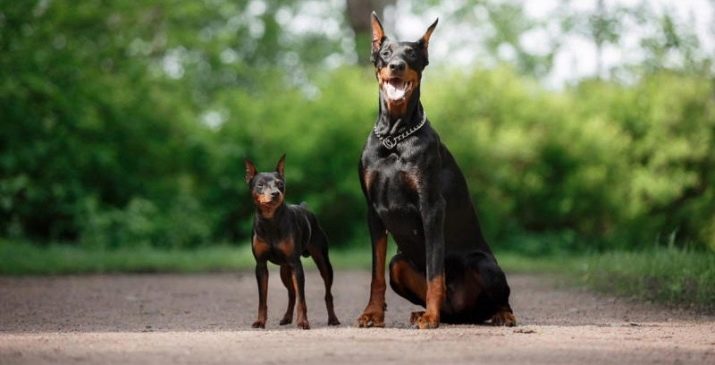
The result was a dog whose height did not exceed 30 cm. It is believed that the smallest smooth-haired dachshunds and Italian greyhounds participated in the creation of the miniature pinscher. Not everything went smoothly along the path of creating this small breed. The work of breeders to reduce the size of the breed has led to the emergence of dogs with signs of dwarfism: with round heads and bulging eyes, excessively noisy and hyperactive.
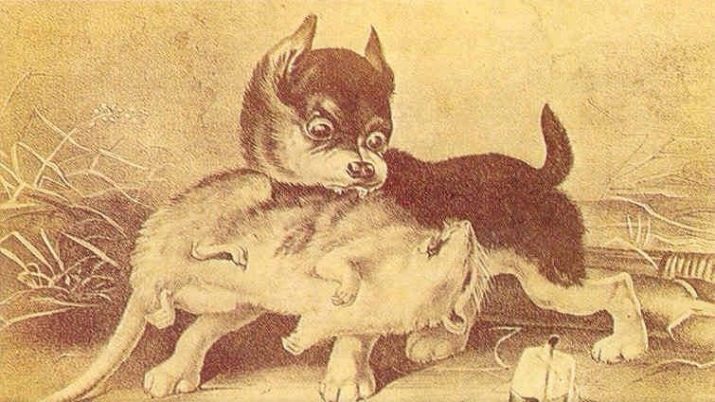
Over time, thanks to the consistent work of breeders, the Miniature Pinscher attracted great interest and became popular. These dogs are very energetic. Despite its small size, the miniature pinscher has excellent watchdog qualities, since their ancestors used to hunt and exterminate domestic rodents.
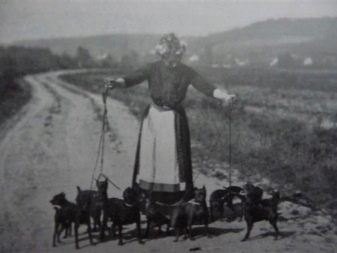
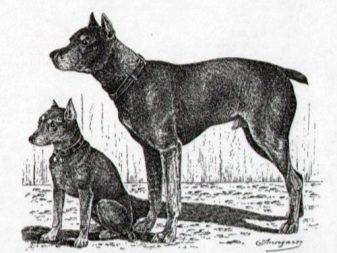
Miniature pinscher - a smaller version of the Medium Pinscher. The dog is distinguished by a stately figure and a strong muscular body.
He has an elongated head set on a noble curved neck. The length of the head (measured from the tip of the nose to the occiput) is equal to half the length of the back (measured from the withers to the base of the tail). The top of the head is flat with a profile parallel to the back of the nose. The ears are high, V-shaped, there are both erect and semi-hanging. Docking of the ears is allowed. The muzzle is elongated, with a well-defined transition from the forehead to the nose. The eyes are dark, oval, the eyelids are closed. The nose and lips are black. Strong jaws, full dentition, scissor bite.
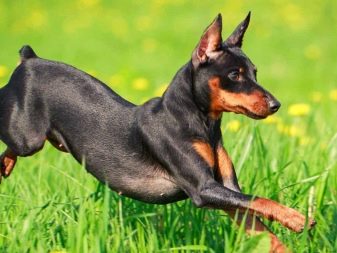
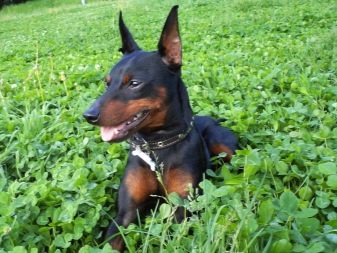
The body is compact, proportional. The top line slopes slightly from the withers to the back. Chest: Moderately broad, oval, reaching to the elbows. The tail is set high, saber or sickle. The forelegs are short, strong, straight, widely spaced. The forearm is well developed and well muscled. The hind legs are slightly longer than the front ones. Feet when viewed from the side are well sloped, when viewed from behind they are parallel, at some distance from each other. The fingers are compressed and convex, the nails are black.
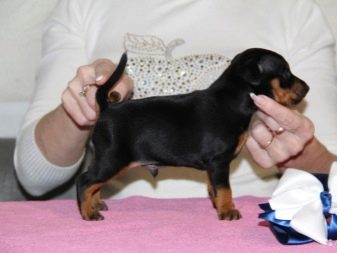
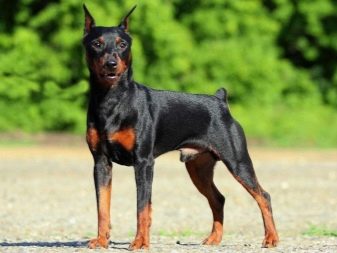
The mini-Doberman's coat is short, shiny, dense. Therefore, they are called smooth-haired. The color of the dogs is presented in two varieties: black and tan and red (from light to brown). These dogs look compact and visually have a square shape, as their body length corresponds to their height. The growth of a miniature pinscher usually does not exceed 25-30 cm, and its weight varies from 4 to 6 kg.
According to breed standards, dogs should not have dwarf features such as a disproportionately large head or thin, weak legs.
A defect is also considered a white impurity in the color. Dogs with defects do not participate in professional breeding of this breed.
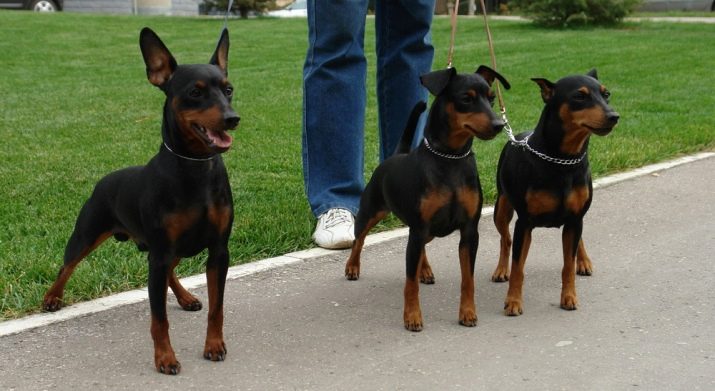
Advantages and disadvantages
As for the content, the miniature pinscher does not need to create special living conditions. The dog can live both in a small apartment and in a house with a large garden. The Miniature Pinscher prefers long and active walks in the fresh air, so it is ideal for people involved in sports.
When keeping a dog in a private house, it is worth remembering that the miniature pinscher is a born hunter. He can search the entire territory in search of rodents or moles.
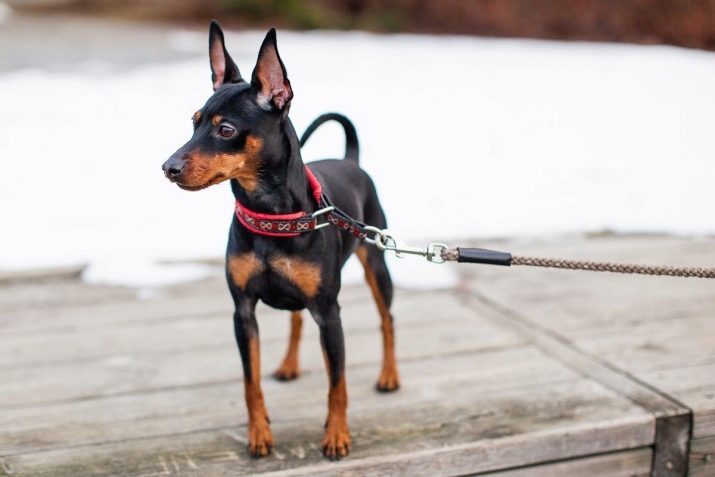
Also, do not leave your pet alone for a long time, he will be very sad, and it does not matter, in an apartment or a large yard, the long absence of the owner will be very tiring for this little pet. Therefore, before starting a miniature pinscher, the future owner must understand that caring for him will take a lot of time.
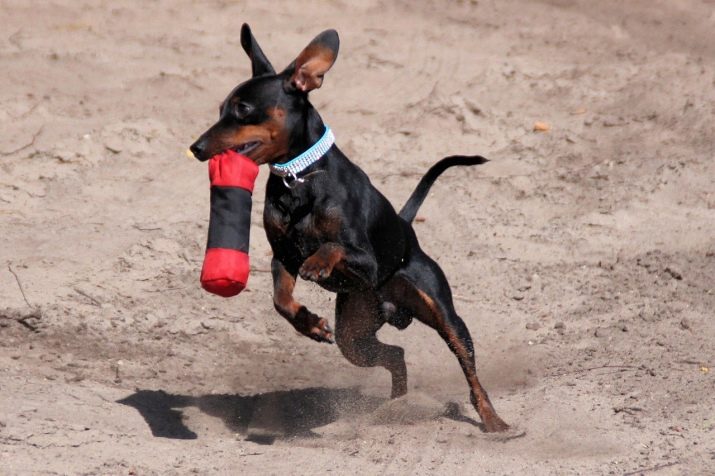
Upbringing is a must for a little pinscher. It avoids many behavioral problems such as loud barking, hyperactivity, aggressiveness.
Dogs of this breed require a lot of attention and love and in return are ready to give their boundless devotion. Best of all, these miniature pets feel close to the person they love. They also prefer to be close to their owner at night, so they need to equip their own bed with a soft and warm blanket.
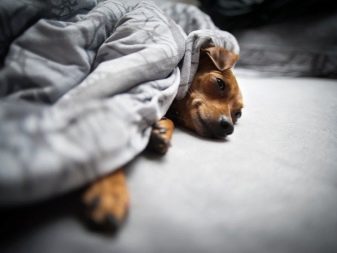
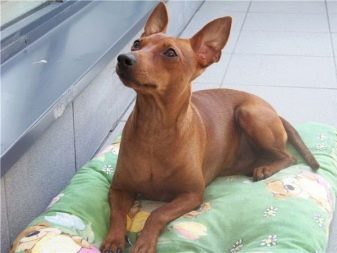
Contrary to popular belief, the Miniature Pinscher does not always bark a lot, but the barking clearly gives him pleasure. If you make mistakes in upbringing, he will become noisy, which can adversely affect both the atmosphere in the family and relations with neighbors. Therefore, you should not admire the dog's barking, on the contrary, all unreasonable attempts to cast a voice should be suppressed.
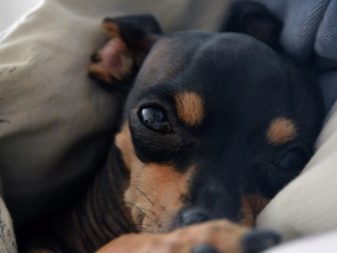
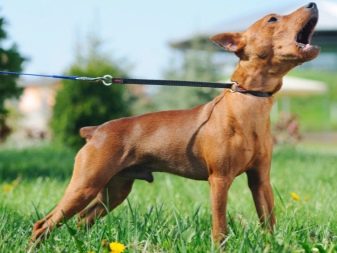
The Miniature Pinscher is an excellent watchman, he always senses and immediately notices that a stranger is standing behind the door. If he feels a threat to his family, despite his small size, he will protect them without hesitation.
The Miniature Pinscher is attached to all family members, but usually singles out one person, the one who devotes the most time to him. Unfortunately, it happens that this devotion quickly becomes a serious problem. Since the pinscher is a hunting dog, it is very easy to become addicted to it. Then he becomes painfully jealous and will try to scare away anyone who dares to approach his master. These can be not only strangers, but also family members. He will launch a whole arsenal of tools - from barking and growling to showing or even using teeth. This behavior must be stopped immediately.
The Miniature Pinscher is an excellent companion for the family and for the elderly, who can give him the most important thing: a lot of love, attention and time. He quickly learns to order, is very loyal to the owner.
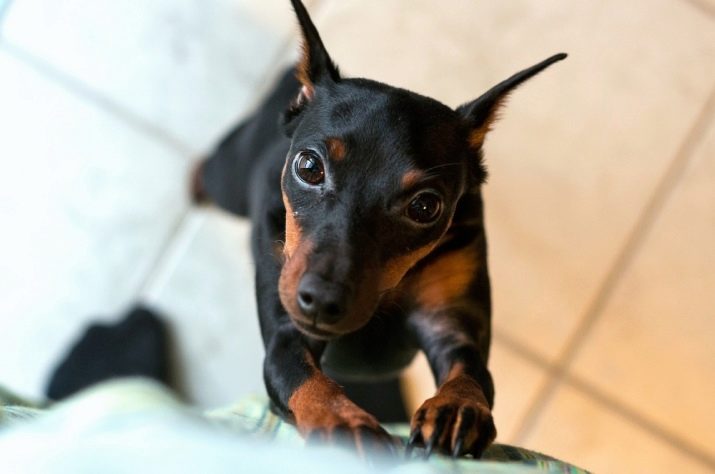
Pinscher loves comfort: a warm blanket and a comfortable seat on the couch. But his most beloved place is on the lap of its owner. The pet guards it jealously and does not really like to share it with someone else. It is worth paying special attention to this behavior, to properly educate the dog.
The Miniature Pinscher is not a caring Newfoundland that will let your child do whatever it wants. The dog treats children well, but if they hurt or scare him, he may even bite.
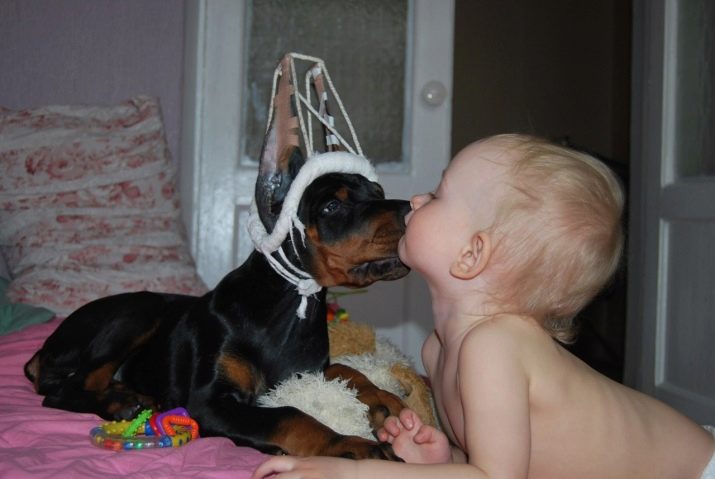
A particularly delicate moment is the appearance of a newborn in the house, especially if before that the dog was the center of attention in the family and is extremely spoiled by everyone. You should not push your pet into the background, and even more so isolate it from the family. He perceives this as a great injustice and quickly associates this change with the arrival of a new family member. This is a very common mistake.
It is imperative to show the child to the pet, allow him to smell, teach him to be careful, clearly establish boundaries that he should not cross. It is important to convince him that the child is not a competitor and not a threat to him.
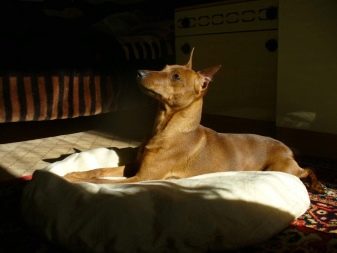
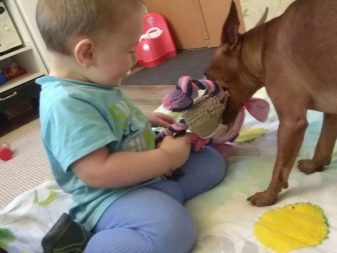
The Miniature Pinscher gets along well with the animals that live under the same roof with him, especially if they are raised together. The only thing that is difficult is to count on friendship with rodents, given the past success of the representative of this breed as an extremely effective rat catcher.
The owner of a miniature pinscher must remember that this little creature has a very strong protective instinct. This can create a tendency in him to confront every dog he meets. Do not let this happen, because every walk will become a nightmare for you instead of pleasure.
As befits a descendant of terriers, he has a very strong hunting instinct, so you need to watch him so that he does not run after some scurrying rodent.
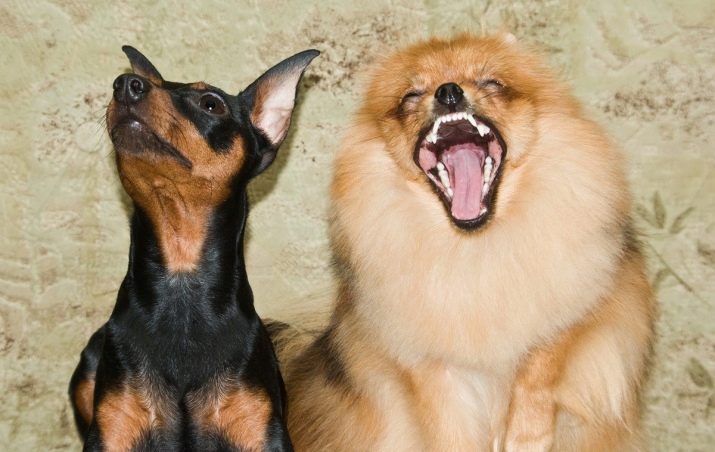
This little pet adapts very easily to the lifestyle of its family. Suitable for both those who like walking and for people who like to travel with the dog. It tolerates travel well and easily adapts to any location.
For a miniature pinscher, one thing is important - to be close to the owner. A change or loss of an owner is a disaster for him, so when deciding to have such a miniature pet, you need to remember this.
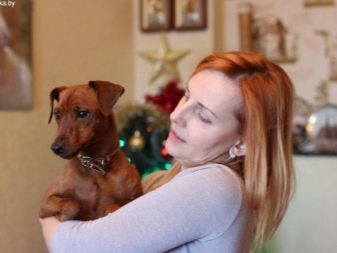
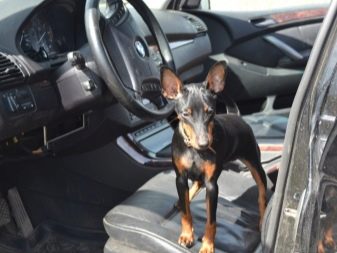
Pros of the breed:
- an ideal companion dog for a family;
- suitable for keeping in any apartment;
- unpretentious in care;
- does not require large maintenance costs;
- good watchman;
- active and positive dog;
- lends itself well to education.
Cons of the breed:
- is hyperactive;
- rather noisy dog, likes to bark;
- can be very jealous and aggressive.
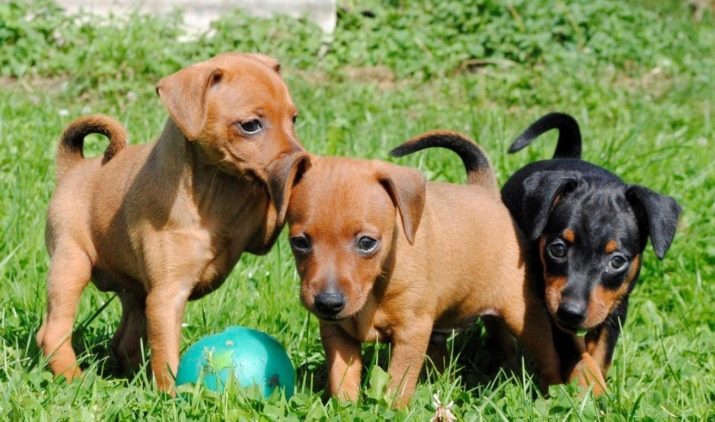
Character traits
The Miniature Pinscher is the best illustration of the saying "there is a great spirit in a small body." This is a dog full of energy, always ready to act. She has a good, but somewhat demanding character. Therefore, it is worth treating it the same way as any large dog, because it is not as harmless as it looks.This dog is ideal for training and playing sports and tolerates very well even long-term stress. But the first signs of fatigue should be a signal to take a break.
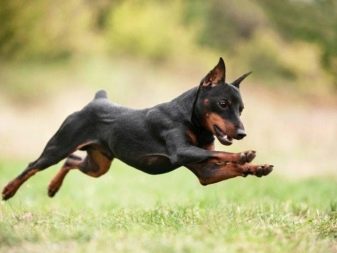
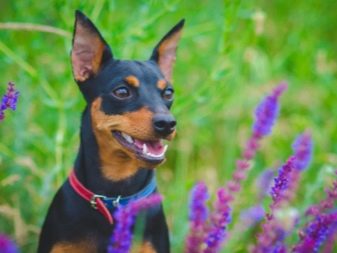
By nature, the Miniature Pinscher is very lively, he likes to be in the center of events. He constantly demands the attention of the family and tries to involve everyone in the fun. When communicating with him, you need to be vigilant and not indulge all his desires. Therefore, from the first days it is necessary to teach him that there is a time for fun and a time for relaxation. Excessive indulgence in his games will make the pet very demanding and moody.
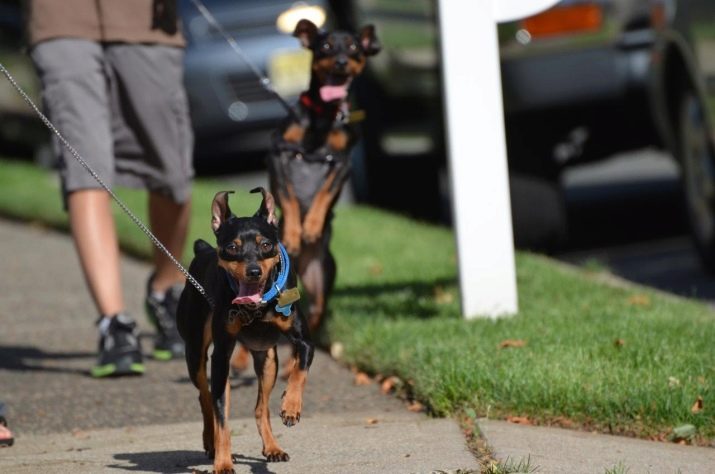
Pinscher is very smart, he needs a variety of activities, but those that attract him both physically and mentally. He can jog with his master, bring toys, look for a hidden object, carry out various commands, or jump over obstacles. Such an active pastime makes both the dog and its owner happy.
The basis for success in raising and training a dog is early socialization and very consistent behavior. Despite its small size, the Miniature Pinscher should not be perceived as a toy. Socialized and well-mannered, he will grow into a wonderful family companion.
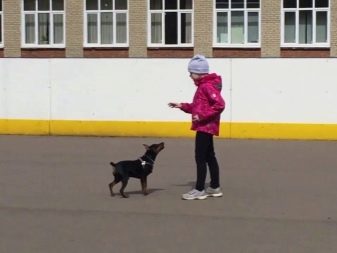
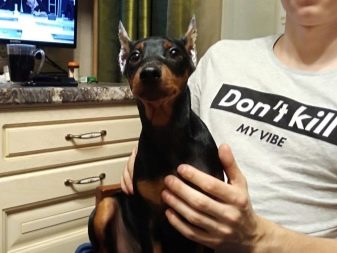
Education should begin from the second month of life, because this dog quickly assimilates privileges and is reluctant to give them up.
By nature, he is very stubborn, so the owner must remain vigilant and always strive to complete the task. Thanks to his natural intelligence, the miniature pinscher readily learns, especially in the game. The host's encouragements and tasty treats have a good effect on the result of training. The use of physical force is not allowed, as this will negatively affect the relationship between the dog and the owner.
These dogs do not like strangers and are wary of them. They also do not enjoy communicating with young children.
Miniature Pinschers are not aggressive, but due to their natural hunting instinct they are excellent guard dogs.
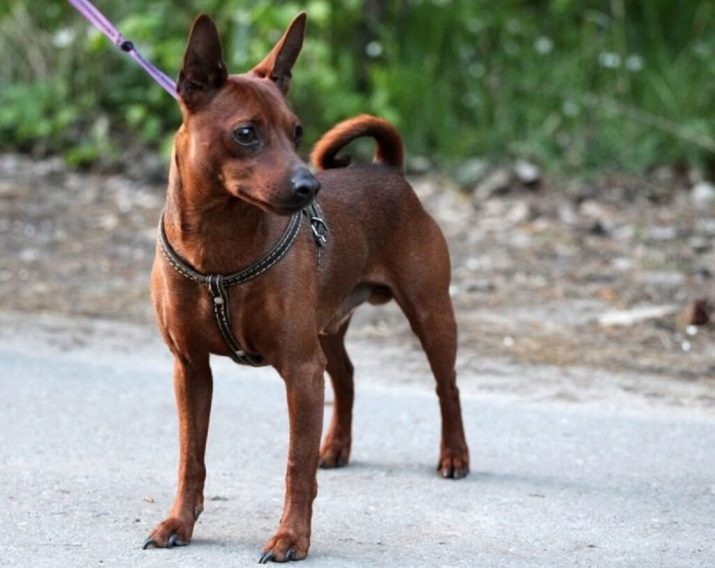
How to choose?
It is worth choosing a pet only from professional nurseries and from conscientious breeders. This will help to avoid health problems of the dog, but it is especially important if the goal is to participate in exhibitions and further breeding.
The determining factor in serious breeding is membership in a breeder's association. The healthy development of Pinschers has always been a priority for professionals.
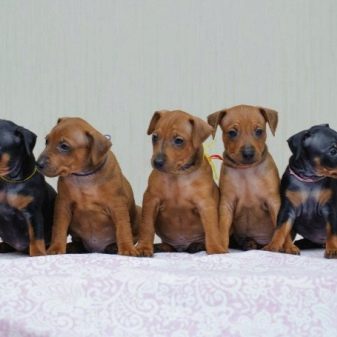
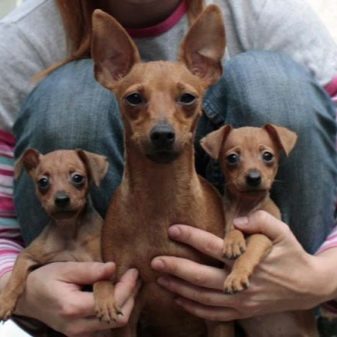
Diseases that are common in small breeds are quite rare in Miniature Pinschers. Miniature Pinschers are considered healthy dogs. Too small individuals, weighing just over 2 kg in adulthood, come mainly from mass uncontrolled breeding. They are usually not recognized by nursery federations.
The Miniature Pinscher is highly sensitive to cold. Their thin ears are especially prone to frostbite. At low temperatures, it is better to dress the Pinscher in warm clothes.
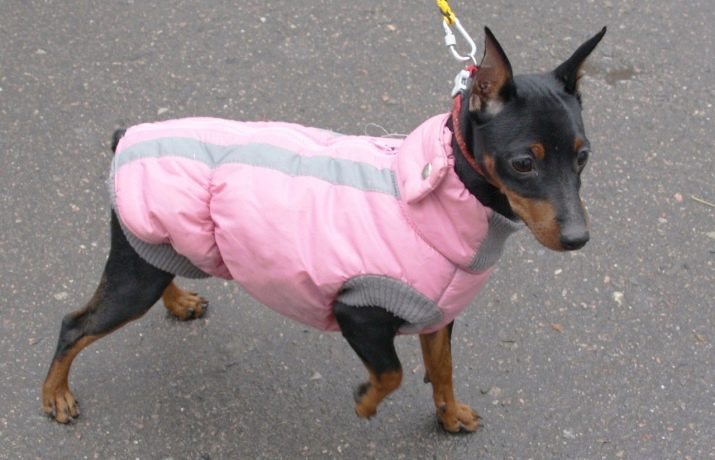
When choosing a breeder, it is imperative to check whether he is guided in his activities by the breed standards recognized by the International Nursery Federation. To be sure of the conditions in which dogs breed, it is better to personally visit the breeder and get to know the puppies. The breeder should describe in detail the properties of the breed you are interested in and advise on many issues related to the upbringing and feeding of the dog.
Naturally, a serious breeder will also be interested in the appropriate conditions for the correct development of the dog available in your home. He'll want to make sure his pets fall into good hands.
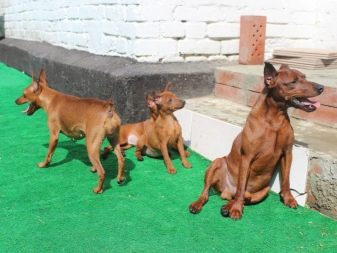

How to name?
The nickname for the pet is selected taking into account individual characteristics: the character, size, temperament of the animal. Some owners prefer to call the dog a simple and common name, others are creative.
Here are some examples of nicknames for a boy:
- Oscar;
- Spike;
- Max;
- Thunder;
- Alex;
- Ball;
- Pluto;
- Ruby;
- Jimmy;
- Diamond;
- Randy.
Nickname options for girls:
- Flora;
- Fiona;
- Jesse;
- Burma.

Content rules
Nutrition
The Miniature Pinscher is a very active dog, so it should get high-protein, healthy and properly balanced food. It is best to choose one of the ready-made mixes designed for small breeds. You need to feed the dog according to its age. It is worth remembering that during active growth, puppies need completely different nutrients and vitamins than adult dogs.
In the first days after birth, puppies should eat their mother's breast milk. At 4 weeks of age, you can already feed your puppy from a bowl. Puppies at the age of 1-2 months are fed 6 times a day, at 2-4 months - 5 times, older puppies - 4 times a day. At the age of 7-12 months, adolescents eat 3 times a day. By the age of 12 months, you need to transfer the dog to two meals a day.
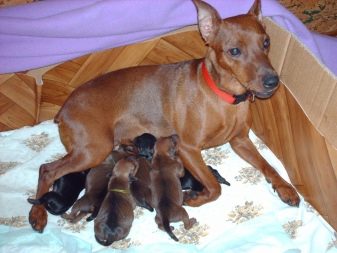
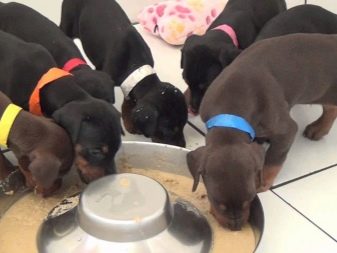
The miniature pinscher can eat both natural products and ready-made food. But it is not recommended to mix both types, it is advisable to teach the puppy any food from childhood. The products used must be fresh and of good quality.
For dry dog food, manufacturers often use cheaper ingredients that can cause allergies or digestive problems. If your puppy develops allergic symptoms after eating a particular food, you should see your veterinarian and change the dish. When feeding dry food, the puppy should periodically be fed fruits and vegetables.
In the first three months of puppies' life, they need to pre-soak dry food in warm water. It is worth remembering that eating dry food increases the animal's need for drinking water. The dry product is given to puppies according to the instructions of the food manufacturer.
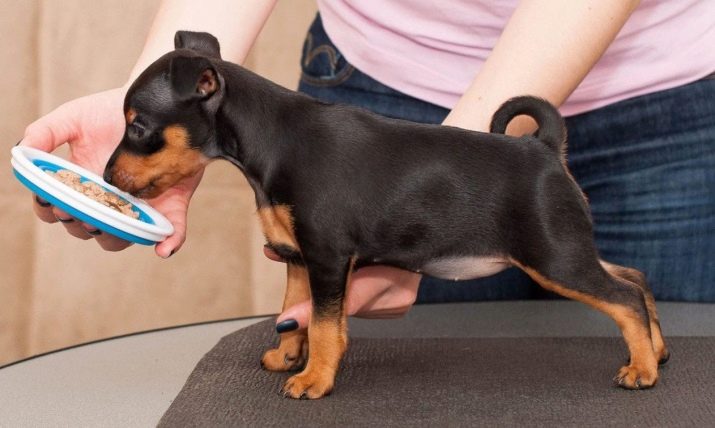
At home, natural food is allowed. In this case, the dog should be given buckwheat, oats and rice boiled in water. Boiled vegetables are also added there. Beets, carrots and cabbage are also used for feeding. An important ingredient in home-based feeding is meat (calf, lamb, lean beef, chicken, and sometimes offal). It is worth adding olive oil and vitamins to food. Puppies need to add cottage cheese, eggs (once a week), fresh or boiled fish to the diet, which must be carefully sorted out of the bones so that the puppy does not choke. You should definitely accustom him to fresh herbs and vegetables. Beans and potatoes are not allowed because dogs do not have enzymes to digest them.
Once a week, it is recommended to give babies finely chopped cloves of garlic - this is an excellent prevention of worms.
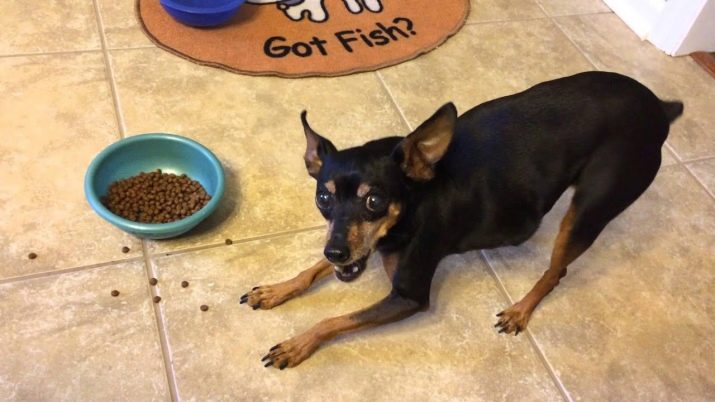
It is not recommended to feed your puppy between meals, and you should not give him food from the table. Sweets are contraindicated for puppies.
The dog is fed from a bowl on a stand, the height of which should change as the dog grows. There should be two cups: with food and water. For the dog's skeleton to form properly, the puppy must reach for the bowl while eating - its top edge should be at the level of the animal's chest. Dogs must have access to water at all times.
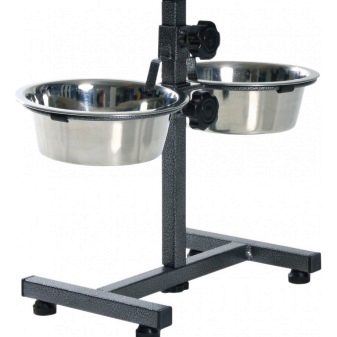
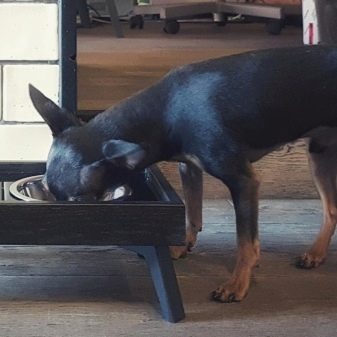
Hygiene
There is a widespread belief that smooth-haired dogs need almost no grooming. Indeed, they have no problems with fur felting, wool tangling. But their unpleasant feature is short bristly hair that falls out almost all year round. They stick to carpets and upholstery and are very difficult to remove. Regular treatment can solve this problem or significantly reduce it.
Hair falls out when the skin on the dog's body is damaged or dry, so it needs constant nourishment. 2-3 times a week you need to moisten it with a conditioner containing high-quality oils, and apply a regenerating balm after the bath. With this care, the wool will strengthen, become thicker, more elastic and will fall out less.
Daily care of a miniature pinscher is simple and does not take much time. It is enough to regularly brush the dog's fur with a brush with thick bristles. The rubber brush is also very good, but only with soft, flexible tips adapted to the size of the dog. Metal brushes are not used for this type of wool.
Bathing the little pinscher is enough four times a year or as the coat gets dirty. For baths, it is worth using special shampoos adapted to this type of wool. It is important to thoroughly rinse the fur of the animal so that the remaining shampoo does not irritate the skin. Sometimes it is allowed to simply wipe the fur with a damp sponge.

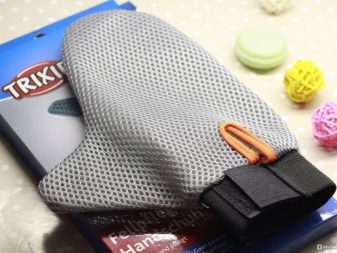
Preparation for the exhibition
Preparing wool for a show is mainly about keeping it in good condition. Wool will look great if sprayed with shine conditioner before taking to the runway. Shake the conditioner before use as oils tend to settle on the surface. This simple treatment will intensify the color and accentuate the musculature.
You also need to pay attention to the paws - the nails should be of such length that they do not touch the floor. If the dog does not grind them down naturally, it is best to do so a few days before the show. It is also worth checking if there are any wounds or abrasions between the pads of the fingers, and if so, you need to treat the wound with medicinal ointment. This is very important because the dog will limp and will not be able to properly present itself at the show.

If the show is held in a hall, the dog may slip and lose balance on a smooth floor. There is a special balm that creates a non-slip film on the pads of her fingers, increases adhesion and helps to eliminate this problem.
Excessive weight can sometimes be hidden in dogs with very thick hair, while in smooth-haired dogs this is impossible. As a result, the dog loses proportion, elegance and sportiness, and hence the chance of success. Therefore, it is advisable to keep an eye on the weight of the dog, avoiding overfeeding.

Care
The miniature pinscher has excellent health and excellent physical shape. Usually these animals live up to 15 years.
It is worth considering that due to the short coat, miniature pinschers are not able to protect themselves from the cold.
Therefore, it is worth taking care of providing them with additional warm clothing - this can be overalls, jackets and pants. For colder weather, choose warmer clothing, preferably with a hood. It is ideal to use boots to keep your feet warm.
When walking in wet weather, you should wear waterproof clothing. The Miniature Pinscher loves to walk, but does not like moisture and cold. He quickly copes with physiological needs on cold days and does his best to get home as soon as possible. And dressed warmly, he can forget about winter and frolic in the snow to his heart's content.
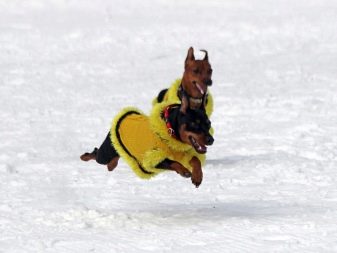
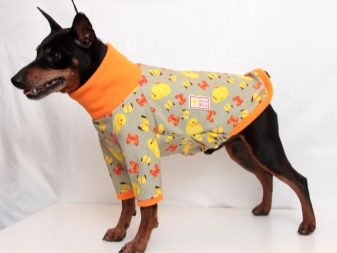
Of the diseases that, although not very common, are found in dogs of this breed, visual impairment should be mentioned. Therefore, when deciding to buy a puppy, you need to look for a kennel where breeders conduct appropriate tests and can confirm that the dogs used for breeding are not susceptible to this disease.
Many pinschers have a tendency to be overweight, so it is worth controlling not only the weight of the dishes, but also limiting the amount of additional delicacies eaten by the animals. This will be useful not only for health, but also for beauty, because the fat pinscher looks unattractive.
In the initial period of life, you should remember about regular deworming and protective vaccinations. Until they are completed, the dog should be quarantined.

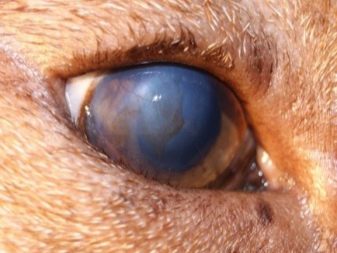
Training
The Miniature Pinscher is a stubborn and active dog, so it needs constant training and good education. She chooses one master, to whom she unquestioningly obeys and is absolutely devoted.Usually there are no problems with the upbringing and training of a miniature pinscher, as he loves to work with people and learns quickly. In the process of upbringing, elements of the game must be present, in this case the dog will be happy to carry out the necessary commands.
This dog performs very well in competitions. Thanks to her hunting instinct, she loves to follow the trail and look for hidden objects.
Miniature Pinscher owners should remember that it is important to ensure regular contact between their pets and other dogs. Otherwise, it will not be possible to properly socialize them, and this will increase the likelihood of abnormal behavior, excessive caution or aggression of the animal.
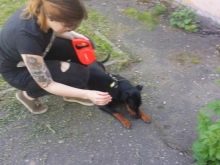
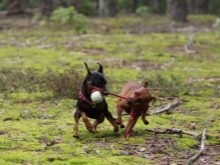

Reviews
The owners of representatives of this miniature breed say that these dogs are sociable and friendly, but prefer silence. In noisy and bustling homes, the dog can become nervous, which often causes unreasonable barking.
The Miniature Pinscher is a great friend for active people who spend a lot of time outdoors or outdoors and are able to provide their pets with physical activity.

Miniature Pinschers are sociable dogs, therefore it is important for them to be constantly near a person. The best option for them would be owners who will not leave them alone for long.
The dog chooses one owner. Usually this is an adult who is an authority for her.
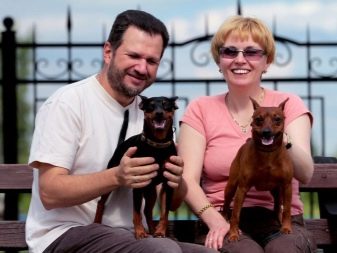

Many owners agree that miniature pinschers do not like small children: they do not allow children to play with them, pick them up, hug, iron. There are times when dogs bite too persistent or noisy children. Sometimes problems are possible due to the dog's jealous attitude towards the owner.
The owners of miniature pinschers note that they are clean, beautiful, loyal, unpretentious in care. These dogs are easy to train and have good health.
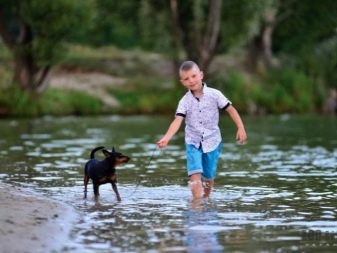
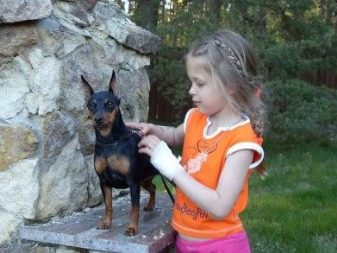
In this video you can learn about the features of training miniature pinschers.



































